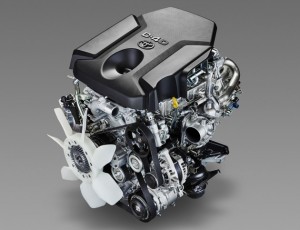Toyota Unveils High-Torque Diesel Engine For LandCruiser Prado – June 19, 2015– Melbourne, Australia (Techreleased) – Toyota has unveiled impressive gains to performance, fuel economy and quietness with the announcement of a newly developed turbo-diesel engine for LandCruiser Prado.

The 2.8-litre Global Diesel (GD) four-cylinder engine has been developed from the ground up to provide confidence-inspiring reliability, robust operation and smooth driving, even when carrying a full load or towing.
It delivers more power and torque – up to 450Nm – while achieving substantially better fuel economy than the Prado’s current 3.0-litre engine.
The new engine, set to arrive in Australia from August, will be mated to a new six-speed automatic transmission instead of the current five-speed self-shifter. A six-speed manual gearbox is also available.
Gearing of the transmissions is specifically designed to unleash the direct-injection common-rail turbo-diesel engine’s potential from just above idle, resulting in brisk acceleration at low to medium engine speeds.
Fuel economy gains of up to 13 per cent have been achieved through an intensive engineering focus on low engine weight, high combustion efficiency and minimum friction.
These measures, along with the adoption of a diesel particulate filter, have resulted in lower emissions and compliance with Euro 5 emissions standards.
Engineers also adopted comprehensive measures to deliver an engine that is notably quiet and smooth, particularly at idle.
These include a chain rather than belt drive, the introduction of a counterbalance shaft, refined component design and strict vibration management.
Toyota Australia’s executive director sales and marketing Tony Cramb said the new 2.8-litre engine will bring even higher levels of performance and driving pleasure to Prado.
“The new Prado engine is better in every way – more power and torque, better fuel economy and reliability, and advanced smoothness and quiet operation,” Mr Cramb said.
“Higher engine outputs make it easier to drive, especially with new levels of low-down torque that promote strong traction, acceleration and pulling power when needed,” he said.
“In addition, the impressively quiet and smooth engine results in a more comfortable atmosphere in the cabin.”
The new engine offers stand-out torque of 450Nm with the six-speed automatic transmission, a gain of 40Nm or more than 9.7 per cent compared with the 3.0-litre engine. Peak torque for the manual version is 420Nm. In both cases, the maximum is available from low engine speeds through to 2400rpm.
Maximum power for the new engine is 130kW at 3400rpm compared with 127kW from the current 3.0-litre turbo-diesel engine – a gain of almost 2.4 per cent despite the smaller engine capacity of around 200cc.
Fuel economy and emissions on the official combined cycle have been improved more than 10 per cent with the manual gearbox to just 7.9 litres/100km*.
Consumption with the automatic version is just one-tenth of a litre higher than the manual and represents an improvement of 5.9 per cent* compared with the current engine and its five-speed unit.
When driving around the city, improvements range from 10.6 per cent for the auto to more than 13 per cent with the manual while the highway figures are as low as 7 litres/100km*.
The new 2755cm3 engine’s electronically controlled common-rail fuel-injection system with piezo injectors supports higher outputs and improved fuel efficiency.
Designated 1GD-FTV, it has high levels of combustion efficiency due to the adoption of a water-cooled exhaust gas recirculation system, a swirl control valve on the intake manifold and a new piston shape.
Weight reduction measures, leading to low energy consumption when driving and therefore better fuel economy, include a new engine cover made from resin and reduced thickness of the cylinder head.
Fuel efficiency has also gained from efforts to produce low engine friction, starting with the adoption of a low-friction timing chain instead of a timing belt, which also helps minimise mechanical noise while idling.
Other efficiency gains come from changing the valve train to a roller rocker type, using a high-efficiency vacuum pump, and implementing measures to reduce abrasion between sliding parts.
Noise suppression is a highlight with significant work was undertaken to tune the sound of the engine, as well as reducing decibels.
The shapes of the intake port, exhaust gas recirculation port and intake manifold have been specifically designed to suppress intake variations and therefore combustion noise in each cylinder.
The exhaust manifold is designed to optimise the retention capacity of the catalytic converter, helping to prevent noise that is characteristic of turbo engines.
Engineers also applied vibration management techniques to the turbocharger and improved the rigidity of its mounts.
The addition of an insulation cover to the oil pan as well as the new resin engine cover also contribute to noise reduction.










